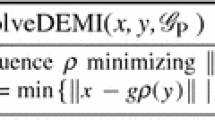Abstract
We study the problem of satisfying the maximum number of distance geometry constraints with minimum experimental error. This models the determination of the shape of proteins from atomic distance data which are obtained from nuclear magnetic resonance experiments and exhibit experimental and systematic errors. Experimental errors are represented by interval constraints on Euclidean distances. Systematic errors occur from a misassignment of distances to wrong atomic pairs: we represent such errors by maximizing the number of satisfiable distance constraints. We present many mathematical programming formulations, as well as a “matheuristic” algorithm based on reformulations, relaxations, restrictions and refinement. We show that this algorithm works on protein graphs with hundreds of atoms and thousands of distances.

Similar content being viewed by others
Data availibility
The datasets generated and analysed in this paper are available upon request from the corresponding author
References
Achlioptas, D., Naor, A., Peres, Y.: Rigorous location of phase transitions in hard optimization problems. Nature 435(9), 759–764 (2005)
Ahmadi, A., Hall, G.: Sum of squares basis pursuit with linear and second order cone programming. In: Harrington, H., Omar, M., Wright, M. (eds.) Algebraic and Geometric Methods in Discrete Mathematics. Contemporary Mathematics, vol. 685, pp. 27–54. AMS, Providence, RI (2017)
Ahmadi, A., Majumdar, A.: DSOS and SDSOS optimization: more tractable alternatives to sum of squares and semidefinite optimization. SIAM J. Appl. Algebra Geometry 3(2), 193–230 (2019)
Amaldi, E., Bruglieri, M., Casale, G.: A two-phase relaxation-based heuristic for the maximum feasible subsystem problem. Comput. Oper. Res. 35, 1465–1482 (2008)
Amaldi, E., Pfetsch, M., Trotter, L.: On the maximum feasible subsystem problem, IISS and IIS-hypergraphs. Math. Program. 95, 533–554 (2003)
Barker, G., Carlson, D.: Cones of diagonally dominant matrices. Pac. J. Math. 57(1), 15–32 (1975)
Barvinok, A.: Measure concentration in optimization. Math. Program. 79, 33–53 (1997)
Berger, B., Kleinberg, J., Leighton, T.: Reconstructing a three-dimensional model with arbitrary errors. J. ACM 46(2), 212–235 (1999)
Berman, H., Westbrook, J., Feng, Z., Gilliland, G., Bhat, T., Weissig, H., Shindyalov, I.N., Bourne, P.: The protein data bank. Nucleic Acid Res. 28, 235–242 (2000)
Bhatia, R.: Matrix Analysis. New York (1997)
COIN-OR. Introduction to IPOPT: A tutorial for downloading, installing, and using IPOPT (2006)
D’Ambrosio, C., Vu, K., Lavor, C., Liberti, L., Maculan, N.: New error measures and methods for realizing protein graphs from distance data. Discrete Comput. Geom. 57(2), 371–418 (2017)
Dias, G., Liberti, L.: Diagonally dominant programming in distance geometry. In: Cerulli, R., Fujishige, S., Mahjoub, R. (eds.) International Symposium in Combinatorial Optimization. LNCS, vol. 9849, pp. 225–236. Springer, New York (2016)
Gerschgorin, S.: Über die Abgrenzung der Eigenwerte einer Matrix. Izvestia Akademii Nauk USSR 6, 749–754 (1931)
Gonçalves, D., Mucherino, A., Lavor, C., Liberti, L.: Recent advances on the interval distance geometry problem. J. Glob. Optim. 69, 525–545 (2017)
Goodall, C.: Procrustes methods in the statistical analysis of shape. J. R. Stat. Soc. B 53(2), 285–339 (1991)
Greer, R.: Trees and hills: methodology for maximizing functions of systems of linear relations. Annals of Discrete Mathematics, vol. 22. Elsevier, Amsterdam (1984)
Hotelling, H.: Analysis of a complex of statistical variables into principal components. J. Educ. Psychol. 24(6), 417–441 (1933)
IBM. ILOG CPLEX 12.9 User’s Manual. IBM (2019)
Lavor, C., Liberti, L., Maculan, N.: Computational experience with the molecular distance geometry problem. In: Pintér, J. (ed.) Global Optimization: Scientific and Engineering Case Studies, pp. 213–225. Springer, Berlin (2006)
Lavor, C., Liberti, L., Mucherino, A.: The interval Branch-and-Prune algorithm for the discretizable molecular distance geometry problem with inexact distances. J. Glob. Optim. 56, 855–871 (2013)
Liberti, L.: Undecidability and hardness in mixed-integer nonlinear programming. RAIRO Oper. Res. 53, 81–109 (2019)
Liberti, L.: Distance geometry and data science. TOP 28, 271–339 (2020)
Liberti, L., Iommazzo, G., Lavor, C., Maculan, N.: A cycle-based formulation of the Distance Geometry Problem. In C. Gentile et al., (ed.), Proceedings of 18th Cologne-Twente Workshop, volume 4 of AIRO, Springer, New York (2020)
Liberti, L., Lavor, C., Maculan, N., Mucherino, A.: Euclidean distance geometry and applications. SIAM Rev. 56(1), 3–69 (2014)
Liberti, L., Marinelli, F.: Mathematical programming: Turing completeness and applications to software analysis. J. Combin. Optim. 28(1), 82–104 (2014)
Liberti, L., Vu, K.: Barvinok’s Naive algorithm in distance geometry. Oper. Res. Lett. 46, 476–481 (2018)
Luisi, P.: Molecular conformational rigidity: an approach to quantification. Naturwissenschaften 64, 569–574 (1977)
Malliavin, T., Mucherino, A., Lavor, C., Liberti, L.: Systematic exploration of protein conformational space using a distance geometry approach. J. Chem. Inf. Model. 59, 4486–4503 (2019)
Mucherino, A., Gonçalves, D.S., Liberti, L., Lin, J.-H., Lavor, C., Maculan, N., MD-JEEP: a new release for discretizable distance geometry problems with interval data. Annals of Computer Science and Information Systems, Sofia, Bulgaria 1–7, 2020 (2020)
Nilges, M., Macias, M., O’Donoghue, S., Oschkinat, H.: Automated NOESY interpretation with ambiguous distance restraints: the refined NMR solution structure of the Pleckstrin homology domain from \(\beta \)-spectrin. J. Mol. Biol. 269, 408–422 (1997)
Sahinidis, N.V., Tawarmalani, M.: BARON 7.2.5: Global Optimization of Mixed-Integer Nonlinear Programs, User’s Manual (2005)
Saxe, J.: Embeddability of weighted graphs in \(k\)-space is strongly NP-hard. In: Proceedings of 17th Allerton Conference in Communications, Control and Computing, pp. 480–489 (1979)
Tawarmalani, M., Sahinidis, N.V.: Global optimization of mixed integer nonlinear programs: a theoretical and computational study. Math. Program. 99, 563–591 (2004)
Author information
Authors and Affiliations
Corresponding author
Additional information
Publisher's Note
Springer Nature remains neutral with regard to jurisdictional claims in published maps and institutional affiliations.
One of the authors (LL) was partly funded by the European Union’s Horizon 2020 research and innovation programme under the Marie Sklodowska-Curie Grant agreement no. 764759.
Rights and permissions
About this article
Cite this article
Bruglieri, M., Cordone, R. & Liberti, L. Maximum feasible subsystems of distance geometry constraints. J Glob Optim 83, 29–47 (2022). https://doi.org/10.1007/s10898-021-01003-4
Received:
Accepted:
Published:
Issue Date:
DOI: https://doi.org/10.1007/s10898-021-01003-4




